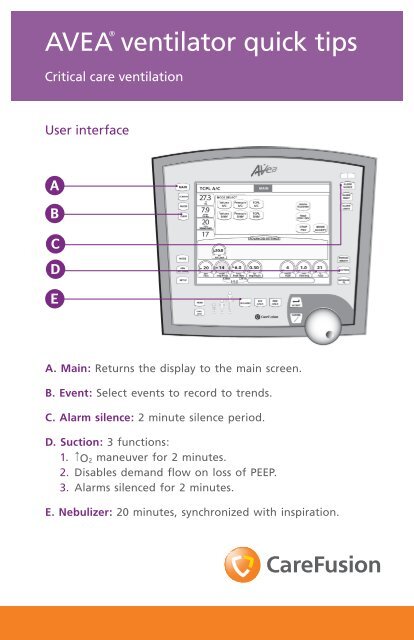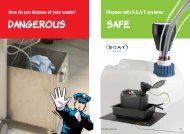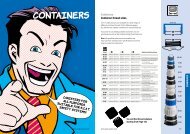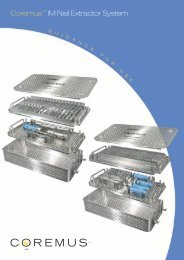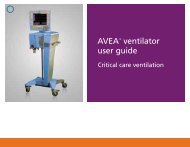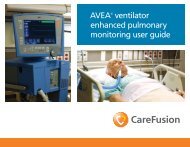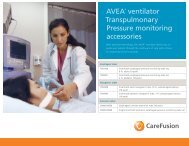AVEA® ventilator quick tips - Presearch
AVEA® ventilator quick tips - Presearch
AVEA® ventilator quick tips - Presearch
You also want an ePaper? Increase the reach of your titles
YUMPU automatically turns print PDFs into web optimized ePapers that Google loves.
AVEA ®<br />
<strong>ventilator</strong> <strong>quick</strong> <strong>tips</strong><br />
Critical care ventilation<br />
User interface<br />
A<br />
B<br />
C<br />
D<br />
E<br />
A. Main: Returns the display to the main screen.<br />
B. Event: Select events to record to trends.<br />
C. Alarm silence: 2 minute silence period.<br />
D. Suction: 3 functions:<br />
1. ↑ O2 maneuver for 2 minutes.<br />
2. Disables demand flow on loss of PEEP.<br />
3. Alarms silenced for 2 minutes.<br />
E. Nebulizer: 20 minutes, synchronized with inspiration.
The AVEA ®<br />
<strong>ventilator</strong>’s <strong>quick</strong> <strong>tips</strong> card is not intended as a replacement for the<br />
operator’s manual.<br />
You must become completely familiar with the operator’s manual before using<br />
the AVEA <strong>ventilator</strong>.<br />
Touch-Turn-Touch <br />
and Touch-Turn-Accept <br />
method<br />
1. Touch the control to select. The control changes<br />
color indicating that it is active.<br />
2. Turn the data dial to reach the selected value.<br />
3. Touch the control again or press ACCEPT to<br />
confirm the change.<br />
Setting alarm limits<br />
1. Press the ALARM LIMITS button to open or<br />
close the window.<br />
2. Use Touch-Turn-Touch or<br />
Touch-Turn-Accept<br />
method to modify alarms.<br />
Proximal flow sensors<br />
The AVEA <strong>ventilator</strong> accepts either hot wire or variable orifice proximal low<br />
sensors. These are in addition to the internal inspiratory flow sensor and heated<br />
expiratory flow sensor.<br />
The variable orifice sensor attaches to the receptacle<br />
circled in dark blue.<br />
The hot wire flow sensor attaches to the receptacle<br />
circled in light blue directly below the variable orifice<br />
flow sensor connection.<br />
To attach, pull back the locking collar. Push firmly onto the receptacle. Push the<br />
collar forward to lock the sensor in place.<br />
To disconnect, retract the collar and pull the connector straight<br />
away from the <strong>ventilator</strong>.<br />
2<br />
1<br />
2 3<br />
1
Monitors and definitions<br />
Volume monitors<br />
Vte Exhaled tidal volume.<br />
Vte/kg Exhaled tidal volume adjusted for patient weight.<br />
Vti Inspired tidal volume.<br />
Vti/kg Inspired tidal volume adjusted for patient weight.<br />
Spon Vt Spontaneous tidal volume.<br />
Spon Vt/kg Spontaneous tidal volume adjusted for patient weight.<br />
Mand Vt<br />
Mandatory tidal volume: Displayed as a rolling average of either<br />
8 breaths or one minute, whichever occurs first.<br />
Mand Vt/kg Mandatory tidal volume adjusted for patient weight.<br />
Vdel<br />
% leak<br />
Ve<br />
Delivered machine volume measured by the <strong>ventilator</strong>’s inspiratory<br />
flow sensor.<br />
Percent leakage: The difference between the inspired and exhaled<br />
tidal volumes in terms of % difference.<br />
Minute volume. Volume of gas exhaled by the patient during the<br />
last minute.<br />
Ve/kg Minute volume adjusted for patient weight.<br />
Spon Ve Spontaneous minute volume.<br />
Spon Ve/kg Spontaneous minute volume adjusted for patient weight.<br />
Rate/time monitors<br />
Rate Breath rate.<br />
Spon rate Spontaneous breath rate.<br />
Ti Inspiratory time.<br />
Te Exhalation time.<br />
I:E<br />
Inspiratory/expiratory ratio.<br />
Note: Not active for demand breaths.<br />
f/Vt Rapid shallow breathing index.<br />
Pressure monitors<br />
Ppeak<br />
Peak inspiratory pressure.<br />
Note: Not active with spontaneous breaths.<br />
Pmean Mean airway pressure.<br />
Pplat Plateau pressure. If no plateau occurs, then the monitor displays.***<br />
PEEP Positive end expiratory pressure.<br />
Air inlet Air inlet gas supply pressure.<br />
O2 inlet Oxygen inlet gas supply pressure.<br />
Gas composition monitors<br />
FiO2 Delivered percent O2.<br />
Mechanics<br />
CDYN<br />
CDYN/Kg<br />
Dynamic compliance (CDYN and CDYN/Kg), absolute and<br />
normalized to patient weight.
Monitors and definitions (continued)<br />
Mechanics (continued)<br />
Cstat<br />
Cstat/kg<br />
Respiratory system compliance (CRS), (a.k.a. static compliance<br />
Cstat), absolute and normalized to patient weight.<br />
Note: This requires an Inspiratory Hold maneuver.<br />
PIFR Peak inspiratory flow rate.<br />
PEFR Peak expiratory flow rate.<br />
Ccw<br />
CLUNG<br />
C20 / C<br />
RRS<br />
RPEAK<br />
RIMP<br />
RLUNG<br />
dPAW<br />
dPES<br />
AutoPEEP<br />
dAutoPEEP<br />
AutoPEEPES<br />
Ptp Plat<br />
The ratio of the tidal volume (exhaled) to the delta esophageal<br />
Pressure (dPES). Requires an esophageal balloon.<br />
The ratio of the tidal volume (exhaled) to the delta<br />
transpulmonary pressure. The delta transpulmonary pressure<br />
is the difference between the airway plateau pressure (during<br />
an inspiratory pause) and esophageal pressure (at the time<br />
the airway plateau pressure is measured) minus the difference<br />
between the airway and esophageal baseline pressures. Requires<br />
an inspiratory hold and esophageal balloon.<br />
The ratio of the dynamic compliance during the last 20% of<br />
inspiration (C20) to the total dynamic compliance (C).<br />
The total resistance during the inspiratory phase of a breath.<br />
Respiratory system resistance is the ratio of the airway pressure<br />
differential (peak–plateau) to the inspiratory flow 12 ms prior to<br />
the end of inspiration. Requires an inspiratory hold.<br />
The peak expiratory resistance (RPEAK) is defined as the resistance<br />
at the time of the peak expiratory flow (PEFR).<br />
The airway resistance between the wye of the patient circuit<br />
and the tracheal sensor. Requires an inspiratory hold and<br />
tracheal catheter.<br />
The ratio of the tracheal pressure differential (peak–plateau) to<br />
the inspiratory flow 12 ms prior to the end of inspiration. Requires<br />
an inspiratory hold and tracheal catheter.<br />
The difference between peak airway pressure (PPEAK AW) and baseline<br />
airway pressure (PEEPAW).<br />
The difference between peak esophageal pressure (PPEAKES) and<br />
baseline esophageal pressure (PEEPES).<br />
The airway pressure at the end of an expiratory hold maneuver.<br />
Requires a passive patient.<br />
The difference between airway pressure at the end of an<br />
expiratory hold maneuver and the airway pressure at the start of<br />
the next scheduled breath after the expiratory hold maneuver.<br />
Requires a passive patient.<br />
The difference between esophageal pressure measured at the end<br />
of exhalation (PEEPES) minus the esophageal pressure measured at<br />
the start of a patient-initiated breath (PES start) and the sensitivity of<br />
the <strong>ventilator</strong>’s demand system. The sensitivity of the <strong>ventilator</strong>’s<br />
demand system is the difference between the baseline airway<br />
pressure (PEEPAW) and the airway pressure when the patient<br />
initiates a breath (PAW start). Requires an esophageal balloon.<br />
Transpulmonary pressure during an inspiratory hold, which is the<br />
difference between the airway plateau pressure (PPLAT AW) and the<br />
corresponding esophageal pressure. Requires an inspiratory hold<br />
and esophageal balloon.
Monitors and definitions (continued)<br />
Mechanics (continued)<br />
Ptp PEEP<br />
MIP<br />
P100<br />
WOBV<br />
WOBP<br />
WOBI<br />
Capnography<br />
EtCO2<br />
VCO2<br />
VtCO2<br />
Vd ana<br />
Vd/Vt ana<br />
Vd phy<br />
Vd/Vt phy<br />
Vd alv<br />
The difference between the corresponding airway and esophageal<br />
pressures at the end of the expiratory hold during<br />
an AutoPEEP maneuver. Requires an inspiratory hold and<br />
esophageal catheter.<br />
The maximum negative airway pressure that is achieved by the<br />
patient, during an expiratory hold maneuver.<br />
The negative pressure that occurs 100 ms after an inspiratory<br />
effort has been detected.<br />
Ventilator work of breathing (WOBV) is defined as the summation<br />
of airway pressure (PAW) minus the baseline airway pressure<br />
(PEEPAW) times the change in tidal volume to the patient (-V)<br />
during inspiration, and normalized to the total inspiratory tidal<br />
volume (Vti).<br />
Patient work of breathing (WOBP), normalized to the total<br />
inspiratory tidal volume. Patient work of breathing is defined as<br />
the summation of two work components: Work of the lung and<br />
work of the chest wall. Requires an esophageal balloon.<br />
Imposed work of breathing (WOBI) is defined as the work<br />
performed by the patient to breathe spontaneously through the<br />
breathing apparatus, (i.e., the E.T. tube), the breathing circuit and<br />
the demand flow system. Requires a tracheal catheter.<br />
Note: Monitored values are displayed as BTPS.<br />
The patient’s peak expired CO2 as measured and reported by the<br />
CO2 sensor in the airway, calculated for each breath then averaged<br />
as specified by set EtCO2 averaging time.<br />
Minute volume of exhaled CO2 measured continuously and<br />
averaged over a user-selectable time. Requires flow measurement<br />
at the wye or circuit compliance active.<br />
Tidal volume of exhaled CO2, measured for each breath and then<br />
averaged over the set VCO2 averaging time. Requires flow measurement<br />
at the wye or circuit compliance active.<br />
The volume of dead space in the patient’s conducting airways<br />
from the nose to the level of the terminal bronchioles measured<br />
for each breath, then averaged over the set CO2 averaging time.<br />
Also includes any mechanical dead spaces added to the <strong>ventilator</strong><br />
circuit between the CO2 sensor and the patient. Requires flow<br />
measurement at the wye or circuit compliance active.<br />
Anatomic Vd/Vt is averaged over the set VCO2 averaging<br />
time. Requires flow measurement at the wye or circuit<br />
compliance active.<br />
Comprises Vd ana as well as the volume of the respiratory zone<br />
(respiratory bronchioles, alveolar ducts and alveoli) not participating<br />
in gas exchange. Requires an arterial blood gas sample.<br />
Physiologic Vd/Vt is averaged over the set VCO2 averaging time.<br />
Requires an arterial blood gas sample.<br />
Alveolar dead space is the difference between physiological<br />
dead space and anatomical dead space. It represents the volume<br />
of the respiratory zone that is from ventilation of relative<br />
under-perfused or non-perfused alveoli. Requires an arterial<br />
blood gas sample.
Monitors and definitions (continued)<br />
Capnography (continued)<br />
VA<br />
P/F<br />
OI<br />
Available modes<br />
Alveolar ventilation is the volume of gas participating in gas<br />
exchange per minute. Requires an arterial blood gas sample.<br />
The PaO2 / FIO2 ratio is a simple assessment of gas exchange<br />
calculated from the FIO2 monitor value and an arterial blood<br />
oxygen measurement (required) entered by the clinician.<br />
Oxygenation index is a dimensionless number often used to<br />
assess the “pressure cost” of oxygenation calculated from the FIO2<br />
mean airway pressure and an arterial blood oxygen measurement<br />
(required) entered by the clinician.<br />
Mode Adult Pediatric Neonatal<br />
Volume A/C X X X<br />
Volume SIMV X X X<br />
Pressure A/C* X X X<br />
Pressure SIMV* X X X<br />
TCPL A/C* X<br />
TCPL SIMV* X<br />
PRVC A/C X X<br />
PRVC SIMV X X<br />
APRV/BiPhasic X X<br />
CPAP/ PSV X X<br />
Nasal CPAP/IMV X<br />
* Volume guarantee breaths available for neonates
Note: Research indicates these pulmonary parameters may aid qualified medical<br />
personnel in evaluating weaning potential. If measured values exceed acceptable<br />
range, successful weaning may be less likely. Ranges from these parameters are not<br />
intended as a substitute for clinical assessment by qualified medical personnel and<br />
CareFusion assumes no liability for their use in patient care. A list of references is<br />
available upon request.<br />
© 2011 CareFusion Corporation or one of its subsidiaries.<br />
All rights reserved. AVEA, Touch-Turn-Accept and Touch-<br />
Turn-Touch are trademarks or registered trademarks of<br />
CareFusion Corporation or one of its subsidiaries.<br />
RC2236 (0511/2000) L3059 Rev. B<br />
CareFusion<br />
22745 Savi Ranch Parkway<br />
Yorba Linda, CA 92887<br />
800.231.2466 toll-free<br />
714.283.2228 tel<br />
714.283.8493 fax<br />
CareFusion<br />
Yorba Linda, CA<br />
carefusion.com<br />
CareFusion Germany 234 GmbH<br />
Leibnizstrasse 7<br />
97204 Hoechberg<br />
Germany<br />
+49 931 4972-0 tel<br />
+49 931 4972-423 fax


